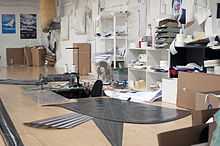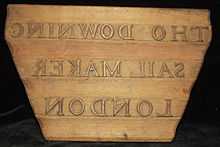Sailmaker
.jpg)
A sailmaker makes and repairs sails for sailboats, kites, hang gliders, wind art, architectural sails,[1] or other structures using sails. A sailmaker typically works on shore in a sail loft. The sail loft has other sailmakers. Large ocean-going sailing ships often had sailmakers in the crew. The sailmaker maintained and repaired sails. This required knowledge of the sailmaker's craft and the tools of the sailmakers loft on shore.[2]
Today, one of a sailmaker's important jobs is to teach people how to set and trim their sails to get the most out of them.[3] Sometimes a sailmaker will accompany the client out on the water and adjust the sails.[4] The modern sailmaker uses computer-aided design and manufacturing tools. Computer graphics allow the sailmaker to produce a "lines drawing" of the sail.[5] Once the design is complete, the sailmaker can now use a low-power laser to cut the material to the exact shape.[6]
Broadseam
The shape or depth of a sail is put into the sail by the sailmaker through the use of curved seams or broadseams.
A simple way of describing this is if you lay two pieces of paper next to each other with one overlapping the other by a fixed amount and stick them together, the result will be a larger flat piece of paper. However, if you cut a curve into one or both of the edges and maintain the same overlap, the result will be a curved surface.
Traditionally this was done "on the floor" by the sailmaker and was called lofting, but modern sailmakers now use computers to perform the calculations, the output files are then sent to a CAD cutting/plotting machine, which will reproduce the individual panels to micrometre accuracy.
This advance in technology has vastly improved the accuracy of sails and has reduced the space needed by the modern sailmaker to construct a sail.
CFD
Sailmakers have recently started using Computational fluid dynamics (CFD), the study of the flow of fluids over or through physical objects, in order to create more efficient sail or foil shapes in the design process.[7]
After CFD analysis is run, complex data sets can be rendered graphically to enhance understanding of the design's likely results, before sails are ever cut.[8]
Sailmaker's tools


- Fid, used to stretch grommets before inserting reinforcement
- Sail palm, an oversized thimble used to drive needles through heavy canvas
- beeswax, used on thread
- Bench hook, to provide a "third hand" to hold sailcloth taut
- Seam rubber, to press folds in to fabric
- sailmaker's needles
- Sewing machine
See also
References
- ↑ http://www.archsails.com/
- ↑ Sager, Eric (1996). Seafaring Labour. Montreal: McGill-Queen's University Press. p. 111. ISBN 0-7735-1523-2.
The first task of the sailmaker was to maintain and to repair all sails, and this required some knowledge of the sailmaker's craft and many of the tools of the sailmakers loft on shore.
- ↑ Mason, Charles (2000). "Mainsail on the Wind : Pointers for Pointing, by Herb Hild". The Best of Sail Trim. Dobbs Ferry: Sheridan House. p. 3. ISBN 1-57409-119-0.
Today, one of a sailmaker's most important jobs is to show his customers how to set and trim their sails to get the most out of them.
- ↑ Marino, Emiliano (2001). Sailmaker's Apprentice. City: International Marine/Ragged Mountain Press. p. 402. ISBN 0-07-137642-9.
Sometimes a sailmaker will accompany the client out on the water and adjust the sails.
- ↑ Garrett, Ross (1996). The Symmetry of Sailing. Dobbs Ferry: Sheridan House. p. 122. ISBN 1-57409-000-3.
- ↑ Crafer, R. (1993). Laser Processing in Manufacturing. London: Chapman & Hall. p. 117. ISBN 0-412-41520-8.
- ↑ http://syr.stanford.edu/RINA_Steve.pdf | TWO-DIMENSIONAL CFD-BASED PARAMETRIC ANALYSIS OF DOWNWIND SAIL DESIGNS
- ↑ http://www.solosails.com/about/cfd Examples of rendered and animated 3D sail CFD simulations